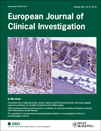Bacteria and spontaneous experimental colitis: immunological changes
Abstract
Eur J Clin Invest 2011; 41 (10): 1047–1053
Background Intestinal commensal flora seems to be a requisite for both human and experimental intestinal inflammation. Our aim was to assess the immunological changes in the colon of IL-10(−/−) mice depending on the environmental conditions.
Materials and methods Twelve wild-type (WT) and 24 IL-10(−/−) 4-week-old mice were kept under specific pathogen-free (SPF) conditions for 4 weeks. Half of them were transferred to a conventional environment. Mice were sacrificed at 12 weeks of age, and the incidence and severity of colitis was assessed. Intraepithelial (IEL) and lamina propria (LPL) lymphocytes were assessed for phenotype and apoptosis by flow cytometry. Toll-like receptors 2 (TLR2) and TLR9 expression was assessed by real-time PCR. Immunohistochemical analyses for cell apoptosis, TLR2 and MyD88 were also performed.
Results IL-10(−/−) mice shifted to conventional conditions showed a greater incidence (66% vs. 50%) and severity of colitis than animals kept under SPF conditions (P = 0·009). The number of CD3+ IEL was higher and their apoptosis rate lower in IL-10(−/−) than in their WT counterparts, regardless of the environment. In LPL, however, these differences were only observed in mice shifted to conventional conditions. TLR2 expression was significantly increased in SPF-housed IL-10(−/−) mice when compared to WT controls. Immunohistochemistry demonstrated the loss of TLR2 and MyD88 in damaged areas.
Conclusions In SPF conditions, IL-10 deficiency appears to be compensated by an increased epithelial TLR2 expression, thus resulting in a milder colonic damage. However, in conventional conditions, this compensatory mechanism would be exceeded inducing a more severe colonic damage with activation of LPL immune cells.




